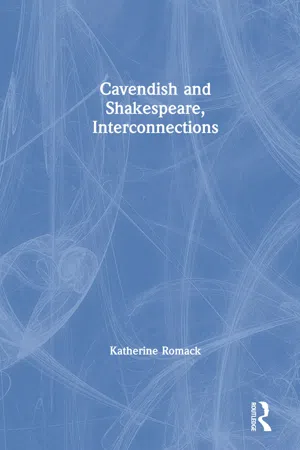
- 230 pages
- English
- ePUB (mobile friendly)
- Available on iOS & Android
Cavendish and Shakespeare, Interconnections
About This Book
Cavendish and Shakespeare, Interconnections explores the relationship between the plays of William Shakespeare and the writings of Margaret Cavendish, Duchess of Newcastle (1623-1673). Cavendish wrote 25 plays in the 1650s and 60s, making her one of the most prolific playwrights"man or woman"of the seventeenth century. The essays contained in this volume fit together as studies of various sorts of influence, both literary and historical, setting Cavendish's appropriation of Shakespearean characters and plot structures within the context of the English Civil Wars and the Fronde. The essays trace Shakespeare's influence on Cavendish, explore the political implications of Cavendish's contribution to Shakespeare's reputation, and investigate the politics of influence more generally. The collection covers topics ranging from Cavendish's strategic use of Shakespeare to establish her own reputation to her adaptation of Shakespeare's martial imagery, moral philosophy, and marriage plots, as well as the conventions of cross dressing on stage. Other topics include Shakespeare and Cavendish read aloud; Cavendish's formally hybrid appropriation of Shakespearean comedy and tragedy; her transformation of Shakespearean women on trial; and her re-imagining of Shakespearean models of sexuality and pleasure.
Frequently asked questions
Information
Chapter 1
“Thou art a Moniment, without a tombe”: Affiliation and Memorialization in Margaret Cavendish’s Playes and Plays, Never before Printed
Table of contents
- Cover
- Half Title
- Title
- Copyright
- Contents
- List of Figures
- Notes on Contributors
- Acknowledgements
- Introduction: Cavendish and Shakespeare, Interconnections
- 1 “Thou art a Moniment, without a tombe”: Affiliation and Memorialization in Margaret Cavendish’s Playes and Plays, Never before Printed
- 2 Shakespeare, Cavendish, and Reading Aloud in Seventeenth-Century England
- 3 Drama’s Olio: A New Way to Serve Old Ingredients in The Religious and The Matrimonial Trouble
- 4 Dining at the Table of Sense: Shakespeare, Cavendish, and The Convent of Pleasure
- 5 Testifying in the Court of Public Opinion: Margaret Cavendish Reworks The Winter’s Tale
- 6 Gender, the Political Subject, and Dramatic Authorship: Margaret Cavendish’s Loves Adventures and the Shakespearean Example
- 7 Old Playwrights, Old Soldiers, New Martial Subjects: The Cavendishes and the Drama of Soldiery
- 8 Enlarging Margaret: Cavendish, Shakespeare, and French Women Warriors and Writers
- 9 The Unnatural Tragedy and Familial Absolutisms
- 10 “I wonder she should be so Infamous for a Whore?”: Cleopatra Restored
- Index